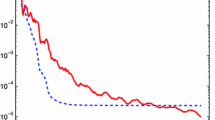Abstract
This paper is devoted to study the cost of the null controllability for the Stokes system. Using the control transmutation method, we show that the cost of driving the Stokes system to rest at time \(T\) is of order e\(^{C/T}\) when \(T \longrightarrow 0^+\), i.e., the same order of controllability as for the heat equation. For this to be possible, we prove a new exact controllability result for a hyperbolic system with a resistance term, which will be done under assumptions on the control region.
Similar content being viewed by others
References
Ervedoza S, Zuazua E (2011) Sharp observability estimates for heat equations. Arch Rational Mech Anal 202(3):975–1017
Ervedoza S, Zuazua E (2011) Observability of heat processes by transmutation without geometric restrictions. Math Control Relat Fields 1(2):177–187
Fernández-Cara E, Guerrero S, Imanuvilov OY, Puel J-P (2004) Local exact controllability of the Navier-Stokes system. J Math Pures Appl 83(12):1501–1542
Fernández-Cara E, Zuazua E (2000) Null and approximate controllability for weakly blowing up semilinear heat equations. Ann Inst Henri Poincaré 17(5):583–616
Fursikov AV, Imanuvilov OY (1996) Controllability of evolution equations. Lectures Notes Series, vol 34. Seoul National University
Guenther RB, Thomann EA (2006) The fundamental solution of the linearized Navier–Stokes equations for spinning bodies in three spatial dimensions: time dependent case. J Math Fluid Mech 8(1):77–98
Guenther RB, Thomann EA (2007) Fundamental solutions of Stokes and Oseen problem in two spatial dimensions. J Math Fluid Mech 9(4):489–505
Lebeau G, Robbiano L (1995) Controle exact de l’équation de la chaleur. Commun Partial Differ Equ 20:335–356
Lions JL (1988) Contrôlabilité exacte perturbations et stabilisation de systèmes distribués. Tome I, Research in Applied Mathematics, vol. 8, Masson, Paris
Lions JL (1992) On some hyperbolic equations with a pressure term. In: Proceedings of the conference dedicated to Louis Nirenberg, Trento. Pitman Research Notes in Mathematics Series, vol. 269. Longman Scientific and Technical, Harlow, pp 196–208
Miller L (2004) Geometric bounds on the growth rate of null-controllability cost for the heat equation in small time. J Differ Equ 204(1):202–226
Miller L (2006) The control transmutation method and the cost of fast controls. SIAM J Control Optim 45(2):762–772
Rocha dos Santos A (1996) Exact controllability in dynamic incompressible materials. Ph.D. Thesis, Instituto de Matemática-UFRJ, Rio de Janeiro
Simon J (1999) On the existence of pressure for solutions of the variational Navier–Stokes equations. J Math Fluid Mech 1:225–234
Solonnikov VA (1964) Estimates for solutions of a non-stationary linearized system of Navier–Stokes equations. Trudy Math Inst Steklov 70:213–317
Temam R (1977) Navier–Stokes equations: theory and numerical analysis. Studies in mathematical appllication vol 2. North-Holland, Amsterdam
Tenenbaum G, Tucsnak M (2007) New blow-up rates for fast controls of Schrödinger and heat equations. J Differ Equ 243(1):70–100
Tucsnack M, Weiss G (2009) Observation and control for semigroups operators. Birkhauser advanced texts
Zuazua E (1995) Controllability of the linear system of thermoelasticity. J Math Pures Appl 74:291–315
Acknowledgments
The author thanks D. A. Souza, J.-P. Puel and E. Zuazua for valuable discussions and comments related to this paper. This work was partially supported by the Grant BFI-2011-424 of the Basque Government and partially supported by the Grant MTM2011-29306-C02-00 of the MICINN, Spain, the ERC Advanced Grant FP7-246775 NUMERIWAVES, ESF Research Networking Programme OPTPDE and the Grant PI2010-04 of the Basque Government.
Author information
Authors and Affiliations
Corresponding author
Additional information
Communicated by Maria do Rosario de Pinho.
Appendix: boundary observability for the hyperbolic system
Appendix: boundary observability for the hyperbolic system
This section is devoted to prove the following result.
Theorem 5.1
If we take \(T > 2R_0\) then, for every solution of (4.4) with initial data \((\phi ^0,\phi ^1) \in V \times H\), the following estimate holds:
For the proof of Theorem 5.1, we need the following two lemmas.
Lemma 5.2
Let \(\overline{q} = \overline{q}(x) \) be in \( C^1(\bar{\Omega })^N\), then, for every regular solution \(u\) of (4.2), the following identity holds:
The proof of Lemma 5.2 is the same as in the case of a single-wave equation, the difference being that here we see the pressure as a force term in the right-hand side.
Lemma 5.3
Let \((u^0, u^1, h) \in V\times H \times L^2(Q)^N\), then the weak solution of (4.2) satisfies:
Proof
The proof is obtained exactly as in the case of the wave equation, first showing the result for regular solutions. Indeed, in this case we must take the vector field \(\overline{q}\) in Lemma 5.2 to be the vector field \(\overline{q}(x) = x\) and use the fact that
\(\square \)
Proof of Lemma 5.1
Without loss of generality, we assume that \(\phi \) is regular and then work with the equivalent problem (4.6). Using Lemma 5.2, with \(\overline{q}\) being the vector field \(m(x) = x\), we have
Next, multiplying (4.6)\(_1\) by \(\phi \) and integrating by parts, we easily see that
Then, using this last identity and the fact that
we obtain
We also have
which implies, by Gronwall inequality, that
Finally, combining all the above estimates, we conclude that
which is exactly (5.1). \(\square \)
Rights and permissions
About this article
Cite this article
Chaves-Silva, F.W. A hyperbolic system and the cost of the null controllability for the Stokes system. Comp. Appl. Math. 34, 1057–1074 (2015). https://doi.org/10.1007/s40314-014-0165-4
Received:
Revised:
Accepted:
Published:
Issue Date:
DOI: https://doi.org/10.1007/s40314-014-0165-4



